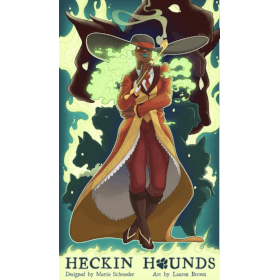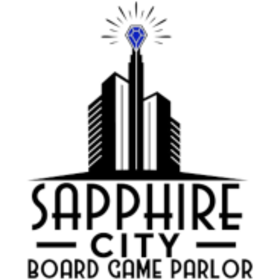Heckin Hounds
 Heckin Hounds es un juego de bazas para 2 a 7 jugadores que explora los peligros de pasear perros de forma profesional en el inframundo.
Heckin Hounds es un juego de bazas para 2 a 7 jugadores que explora los peligros de pasear perros de forma profesional en el inframundo.
Los jugadores tienen la tarea de ir a la colección de sabuesos de Hades. Haga su trabajo demasiado bien y ella lo ascenderá a gerente, una responsabilidad temida en todo el reino. Haz tu trabajo demasiado mal y serás degradado a comida para perros profesional.
El juego se juega con la mano mirando hacia afuera, lo que no te da conocimiento de los sabuesos que tienes. Cada ronda tiene un jugador diferente que actúa como líder del turno, que puede ver tanto su mano como la de los demás. El líder de turno le da a cada jugador tres pistas sobre los sabuesos que tienen: cómo de útiles, inútiles o engañosas dependerá de ti, pero deben ser ciertas. El líder de turno también asigna a Cerbero a un jugador, un cachorro de carta de triunfo que gana cualquier baza en la que se juegue.
Los jugadores tienen algunas oportunidades para probar y administrar su suerte, y deben decidir cuántos turnos trabajarán (trucos que tomarán) en función de la información limitada que tienen de su propia mano y las manos de los otros jugadores que pueden ver. Se juegan cartas, se ganan bazas y comienza una nueva ronda.
Después de que todos hayan tomado su turno como líder de turno, el juego termina. ¡El jugador que obtuvo la menor puntuación sin ser negativo hizo la menor cantidad de trabajo sin ser despedido y gana el juego!
Por eso, Heck in Hounds es un juego de ser apenas adecuado.
Número de jugadores: 2 - 7
Duración de la partida: 25 mn
Complejidad: 3 / 5
Juega Heckin Hounds y 1194 otros juegos en línea.
No es necesaria ninguna descarga - juega directamente desde tu navegador.
Con tus amigos y con miles de jugadores del mundo entero.
Gratis.

Juega Heckin Hounds y 1194 otros juegos en línea.
No es necesaria ninguna descarga - juega directamente desde tu navegador.
Con tus amigos y con miles de jugadores del mundo entero.
Gratis.

Sumario de reglas
[These instructions are taken from, and in some cases modified, from the Heckin Hounds rulebook]
Big Picture
Heckin Hounds is a trick taking game where you don't always know what cards you have and get the chance to provide incomplete information to the other players. As a part of your dog walking responsibilities, you must promise (bid) to work a certain number of shifts (take a certain number of tricks) each round. If you make good on your promises (make your bid) your points don't change. If you under promise (underbid - take more tricks than bid) you gain points. If you over promise (overbid - take fewer tricks than bid) you lose points. The game lasts a number of rounds equal to the number of players. At the end of the final round, the player at zero points or closest to zero points, while not being negative, wins the game.
The Cards
The game is played with six unique suits of cards and a single all-powerful trump card, with the following top to bottom trick-taking hierarchy:
- Cerberus - all powerful, takes any trick. The Shift Leader assigns it to one player each round.
- Deathpaw - Suit is included in the initial hand deal.
- Paulgrave - Suit is included in the initial hand deal.
- Sudachi - Suit is included in the initial hand deal.
- Tom Dire - Suit is included in the initial hand deal.
- Evil Molly - Suit is included in the initial hand deal.
- Mops - The lowest ranked Mops suit is not included in the initial hand deal, but is instead mixed with the undealt cards to form a 'dead hand'. During the round preparation, each player will have a chance to blindly exchange one of their cards with a card in the dead hand.
Each of the dog suits contains numerical cards going from 1 to N+1, where N is the number of players. So, for example, in a 4 player game the suit cards valued 1 through 5 would be used.
BGA Gameplay Overview
Heckin Hounds is played over a number of rounds equal to the number of players, each consisting of five tricks. Each round is overseen by a Shift Leader. The Shift Leader can see everyone’s hand, including their own. All other players can only see the hands of all the other players who are not the Shift Leader. The overall game flow on BGA is:
- The Shift Leader performs the following tasks:
- Chooses which suit is the 'bad dog'
- Gives three clues to each player about the dog cards in their hands
- Assigns Cerberus to a player
- Players, starting with the Shift Leader, perform the following tasks:
- Choose whether or not to trade with the dead hand
- Promise/bid to take a certain number of tricks/shifts
- The five tricks/shifts are played, with the Shift Leader leading a card for the first shift/trick
- After the fifth shift/trick, the round is scored and the Shift Leader rotates to the next player
- After the last round, the final score is determined
BGA Gameplay Details
- The Shift Leader performs the following tasks:
- Chooses which suit is the 'bad dog'
- The bad dog assignment is an end of game tie-breaking mechanism. If a player takes a trick with a bad dog in it, the players bad dog score increases by one point for each bad dog card they have taken.
- The bad dog for the round is indicated by the "+1" black circle on the hound suit hierarchy list.
- Gives three clues to each player about the dogs in their hands
- The Shift Leader provides three clues to each player regarding their hand of cards. The Shift Leader can provide as little or as much information as possible and is not required to provide clues on every card. Clues are given by clicking on a card and selecting from the available clues options. Indicator tokens are automatically placed next to the cards based on the clues provided. Each set of clues must provide new information, but a single clue can lead to duplicate information having been given. Each clue must follow one of these three rules:
- Hound name/type (at least two cards, and all cards of that hound must be pointed out)
- Hound value (at least two cards, and all of that value must be pointed out)
- Both hound type and value for a single card.
- The Shift Leader provides three clues to each player regarding their hand of cards. The Shift Leader can provide as little or as much information as possible and is not required to provide clues on every card. Clues are given by clicking on a card and selecting from the available clues options. Indicator tokens are automatically placed next to the cards based on the clues provided. Each set of clues must provide new information, but a single clue can lead to duplicate information having been given. Each clue must follow one of these three rules:
- Assigns Cerberus to a player
- Cerberus is the worst dog in the underworld to walk and automatically wins the trick it is played on. The Shift Leader assigns one player, which can be themselves, to take Cerberus. The chosen player discards one card of their choice from their hand and replaces it with Cerberus. The discarded card is out of play for the round and is not placed in the dead hand.
- Chooses which suit is the 'bad dog'
- Players, starting with the Shift Leader, perform the following tasks:
- Choose whether or not to trade with the dead hand
- The starting dead hand is made up of the Mops suit cards and the remaining undealt cards at the start of each round.
- Each player, starting with the Shift Leader and proceeding clockwise, may optionally trade one card (but not Cerberus) with the dead hand. This card is set aside face down, a new card is drawn from the dead hand, and finally the set aside card is shuffled into the dead hand before the next player chooses to trade. Any player that chose to trade receives a Mops token next to the new dead hand card to help remind them which card they traded in, that now may or may not be Mops.
- Cards taken from the dead hand remain hidden from everyone until all players have chosen whether to trade with the dead hand. When all players have made their choice, the traded cards are revealed according to the players' positions (Shift Leader or not).
- Promise/bid to take a certain number of shifts/tricks
- Each player, starting with the Shift Leader and proceeding clockwise, promises (bids) to work a number of shifts (take a certain number of tricks). A player can bid between 0 and 5 shifts in a single round.
- Choose whether or not to trade with the dead hand
- The five shifts are played, with the Shift Leader leading a card for the first shift
- Starting with the Shift Leader and proceeding clockwise, each player plays any card in their card stand face up into a shift. A player does not need to follow hound suit.
- The winner is whomever plays the hardest to walk dog - Cerberus is harder to walk than Deathpaw, who is harder to walk than Paulgrave, and so forth. In the case of two of the same hound being played, the one with the higher value is the harder to walk.
- The cards are collected and, if any of those cards were the extra bad dog, the winning player gains one badness point for each extra bad dog that they had to walk.
- Tricks taken in the current round are tracked in the 'Shift' location near the player's name.
- The player who won the trick, leads any card to begin the next trick.
- After the fifth shift, the round is scored. After the last round, the final score is determined, else the Shift Leader rotates to the next player
- If a player bids more tricks than they took then decrease their score one point for each trick they missed
- If a player took more tricks than they bid then increase their score by one point for each extra trick.
- If a player took the exact amount of tricks they bid then the player has no change in score.
End of the Game
After each player has had a turn being Shift Leader, the game ends and final scores are tallied. The player with the lowest score (zero, or closest to zero) without being negative, wins the game. In the case of a tie, the player with the lowest badness value (earned from all the bad dog cards taken in tricks) wins the game. If there is still a tie, all tied players win.

